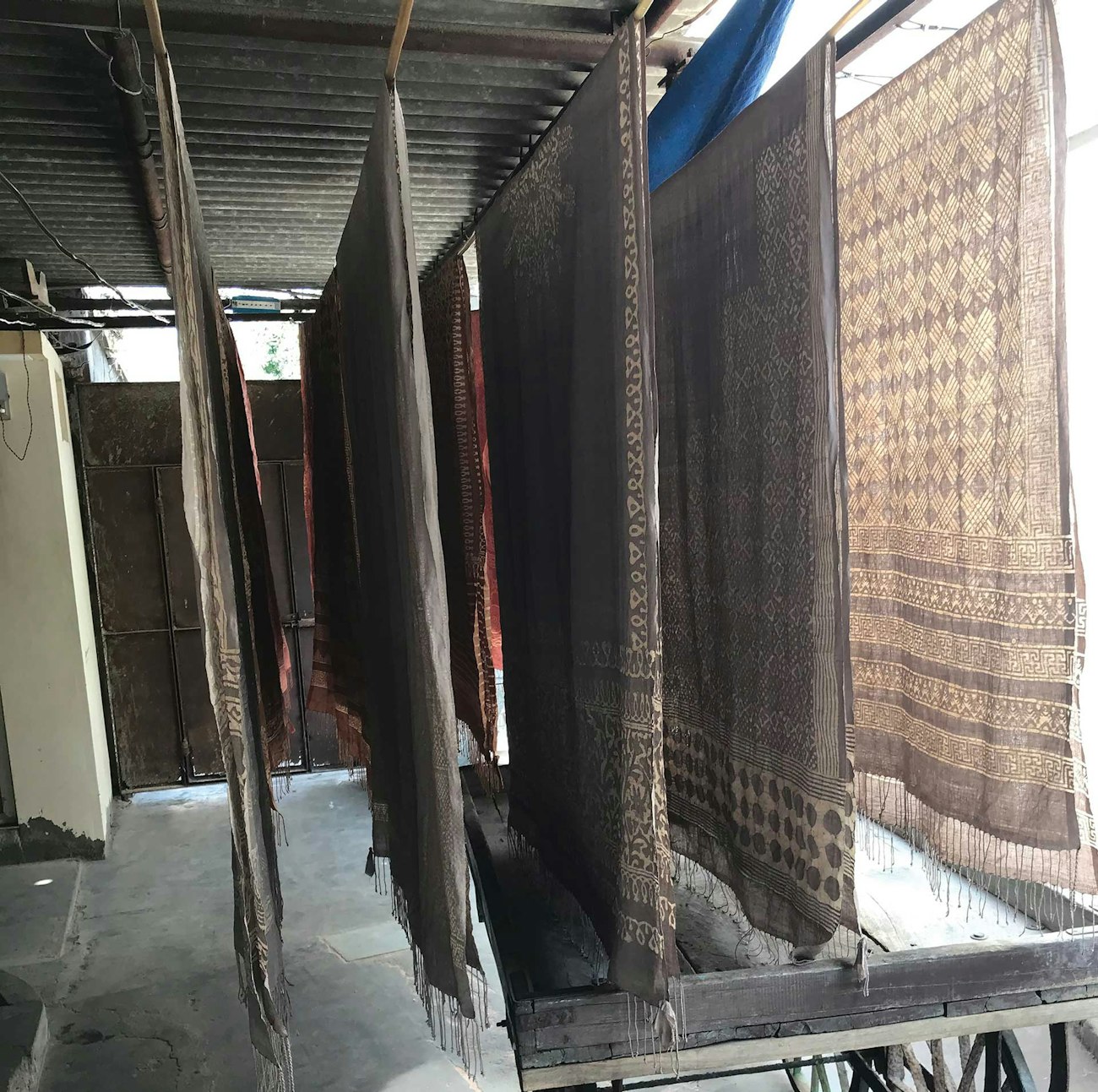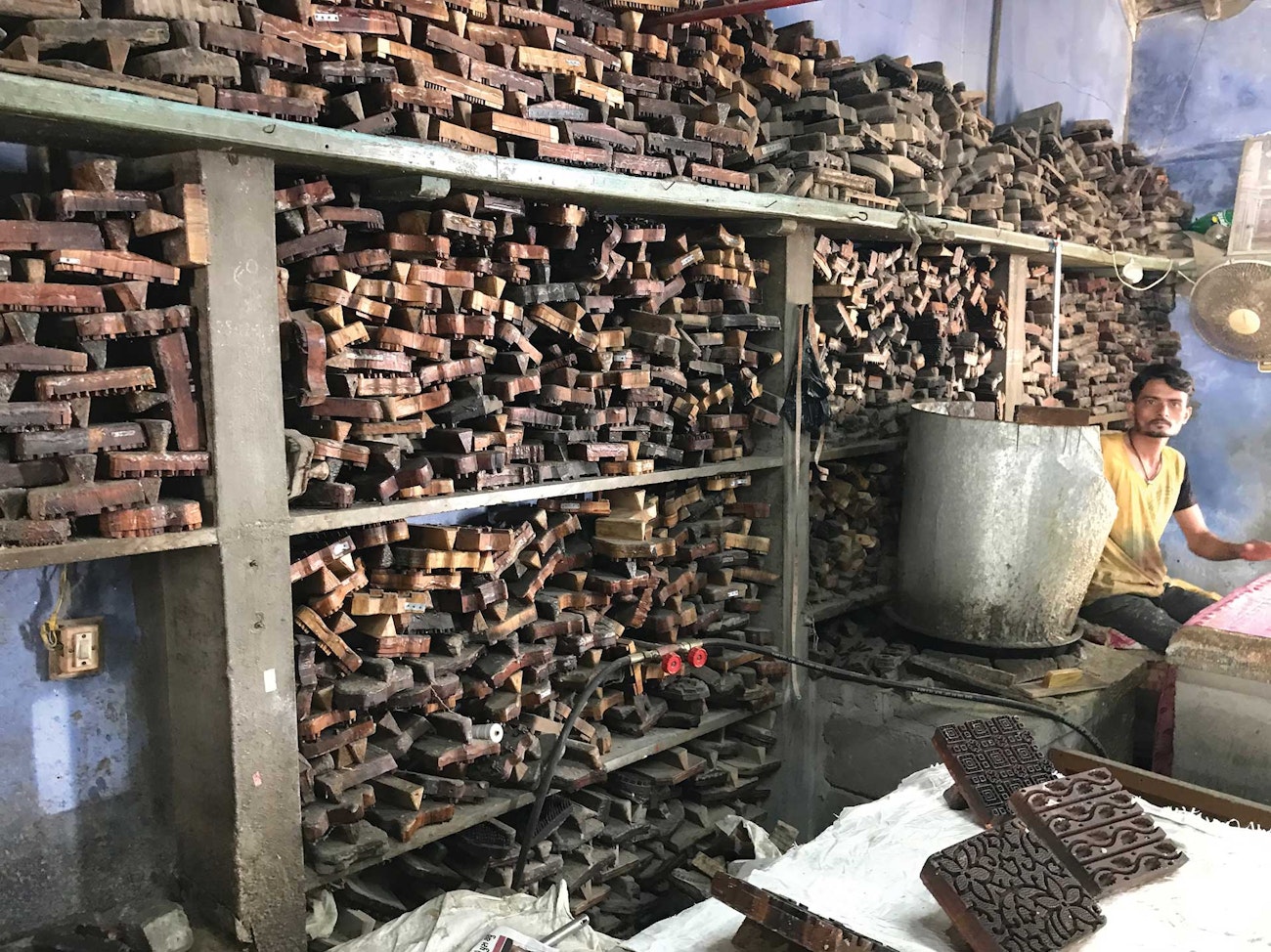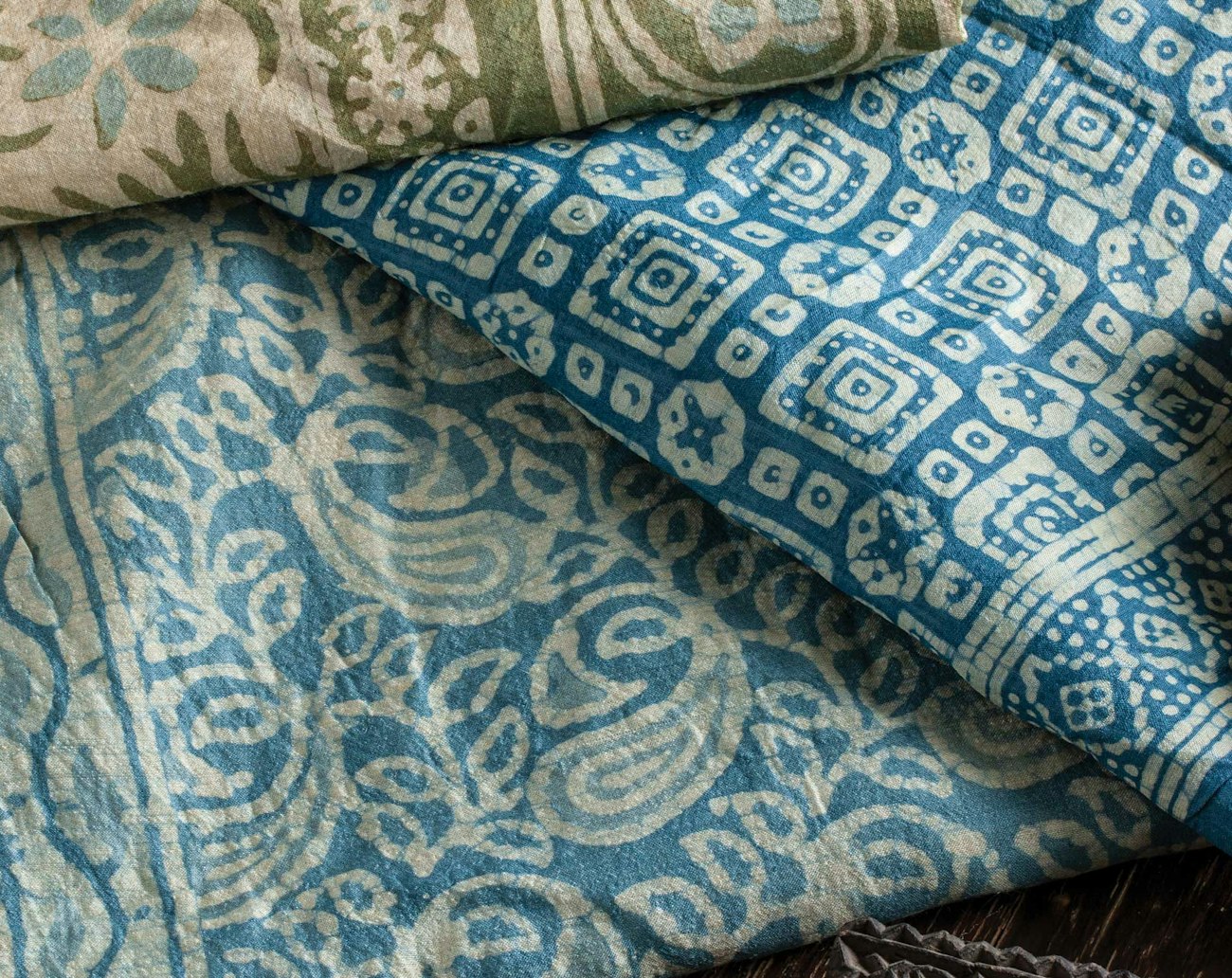The Indian tradition of block printing batik fabric has undergone vast changes over the past 80 years. Read how one family returned to the roots of their craft, restoring batik's authentic beauty by honoring their traditions and the living colors of India.
Tucked away in a remote village of Mundra, a port city on the Gulf of Kutch in the district of Gujarat, India, Shakil Khatri’s family has been practicing the craft of batik block printing for at least six generations.
Before the 1950s, when petroleum-based paraffin was introduced, the patterns of traditional batik used the oil of the pilu tree (Salvadora persica), locally known as kakhan, as a resist. It has a very thick consistency but is sensitive to heat—so much so that block printing with pilu oil was carried out only in the cool early-morning hours.

The productivity of Shakil's workshop is impressive, given the exacting nature of the process.
The fabric printed with pilu oil was dyed in cold vats of indigo or fermented iron for shades of blue and black, respectively. Then the iron-dyed fabrics, washed and free from pilu oil, were boiled in madder to get red tones in the previously white-resisted areas. The overdye of red didn’t affect the black background, and this color combination of red and black was very common in traditional batik. These natural-dyed batik fabrics were not traded beyond the local farming communities of the Ahir, Baniya, and Patel castes.
Traditions Left Behind
By the time Shakil Khatri embarked upon his journey with batik in 2002, the traditional ways of making and trading had all but disappeared. The consumer shift happened in the late 1940s, the post-independence period, as factory-made textiles found their way into the local markets. Their enticing variety lured the locals away from handmade textiles.
This shift prompted many batik artisans to leave the craft. Shakil’s granduncle Ismail, a well-educated gentleman, left for Mumbai to earn a livelihood. The craft’s artisans were in vigorous search of new markets.
In Bombay, Ismail saw batik textiles from other parts of India. They were resisted with paraffin wax and dyed in cold-water naphthol-based dyes. Emulating the new market conditions, Kutch batik transitioned from natural dyes to naphthol-based dyes. The new batik prints were modern and bright and colorful.

Shakil’s father, Kasam, amassed a large library of hand-carved printing blocks over three decades.
This revived batik. But this moment of sudden change proved to be a bleak period as the craft and the maker lost their identities and the prestige they had once enjoyed. The market began to be saturated with low-priced, poorly done batik textiles.
“It was the 1990s. As the batik crisis deepened, my father, Kasam, and his brothers Mohammed and Ayub felt the need for new alternatives to emerge in order to sustain life in batik,” says Shakil. Kasam, a master printer and block designer, innovated with prints and designs. His brothers Mohammed and Ayub focused on the quality of dye and color. Soon their workshop began to produce textiles of high workmanship.
Making Connections
Though unquestionably good, the textiles still lacked the authenticity of the past—the identity and the prestige those textiles had borne. Or so thought Shakil’s uncle Ayub when he set about the revival of batik with natural dyes in 2005. Meanwhile Shakil developed a fine, delicate hand for printing textiles of exquisite beauty.
Ayub convinced Shakil to enter the design program at Kala Raksha Vidhyalaya, an art school program that imparts design education to Kutch artisans and builds networks. Shakil began the course in 2009 in order to experience design and social interactions that went beyond consumer capitalism. “The interactions there with designers, craft activists, and educators made me realize the oblivion the craft has sunk into. People weren’t even aware of the existence of batik in Kutch,” Shakil says. Faced with this vulnerable situation, Shakil understood the need to change the approach to his craft and to fashion batik, making textiles that would be more durable in the message they carry.
Judy Frater, director and founder of Kala Raksha, noticed the fine craftsmanship of Shakil’s textiles. She helped him foster collaborations with designers and encouraged him to pursue the use of natural dyes. Shakil, too, understood the challenge of making fashion sustainable. But going back to the roots and working with natural dyes meant reorchestrating the pace of the craft.
The Stories of Craft
“It was only my uncle Ayub’s passing away in 2013 that made me pause and acknowledge his vision and think of the social nature of fashion. That the sociality of fashion and creating identities is also about the stories we want to tell about the craft,” adds Shakil.“I took up the revival from where my uncle left off. He achieved success with indigo but was very limited with other natural dyes. Indigo is a cold-dye vat. But other natural dyes require long application of heat for the dye to adhere to the cloth, which affects the areas resisted with paraffin wax.”
A weeklong natural-dye workshop at Kala Raksha helped Shakil to understand the behavior of natural dyes at different temperatures. “Working with natural dyes in batik is a very delicate process because of the presence of wax. It takes one week to prepare batik textiles in natural dyes, while it takes only a day with chemical dyes,” says Shakil. But the resulting natural tones in batik are very unusual compared to other natural-dyed textiles. They are pastel in shade. Calm and muted. Simple and elegant.

Handwoven scarves of tussar silk are stamped with motifs traditional to women’s wedding attire. In earlier times, the colors would have been red and black.
Today: the Allure of Authenticity
Shakil makes about 12 shades of natural colors from such ingredients as indigo, rust iron, haldi (turmeric), pomegranate skin, madder root and alizarine, cutch (Acacia catechu), henna, tea leaves, onion skins, and more. And the huge library of wood-block patterns his father, Kasam, created over the past three decades are helping Shakil to create a beautiful visual language. And to ensure a perfect sense of harmony, he uses high-quality handmade textiles for the natural-dye batiks.
In the past three years, a steady flow of travelers have come to Shakil’s remote workshop in Mundra, people who hope to experience a personal narrative in textiles that have withstood the cyclical nature of the consumer market. “People respond to authenticity instinctively. When someone visits our workshop, we begin with our batik collection of scarves that use azo-free synthetic dyes. People like them and appreciate them; they respond to the craftsmanship and the technique. But as we move on to natural-dyed batik textiles, the entire atmosphere in the room changes. There is fresh new energy. Everyone becomes more awake. People get more engaged with the textiles. They hold them close to their skin. Smell them. Questions about the craft, the history, the process, the natural dyes begin to flow along with the textiles. Until the chai comes to the table. Then we all take a small break, sipping chai with smiles on our faces.”
We invite you to explore these textile traditions and natural dyes with these additional resources:
You can learn more about textile traditions from Kala Raksha founder Judy Frater in our upcoming Winter 2025 issue. Subscribe today to get this issue delivered to your inbox the day it goes live on October 9, 2025.
Explore natural dyes, the lives of 18th-century English dyers, a celebrated Navajo dyer, and more in the Nature's Colorways book.
In this podcast episode, Keith Recker recounts how his lifelong passion for color led him into enchanting worlds where people surround themselves with natural dyes like turmeric and indigo.
Originally published November 24, 2021; updated August 11, 2025.

